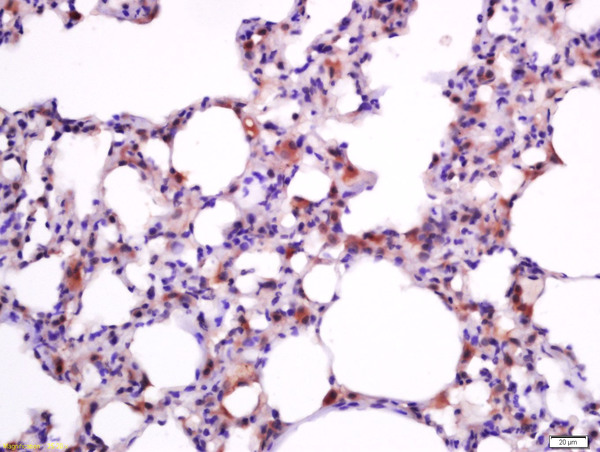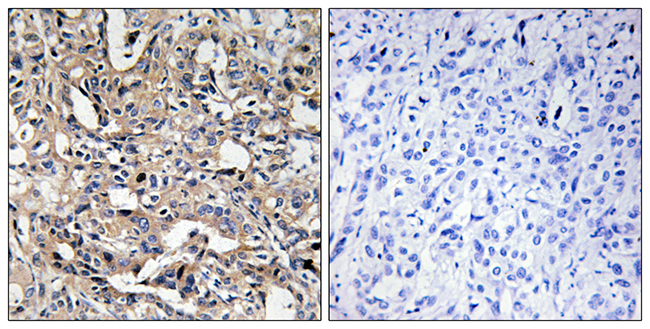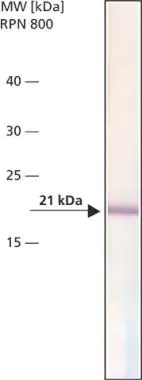Bax antibody [N1N2], N-term
GTX109683
ApplicationsImmunoFluorescence, ImmunoPrecipitation, Western Blot, ImmunoCytoChemistry, ImmunoHistoChemistry, ImmunoHistoChemistry Frozen, ImmunoHistoChemistry Paraffin
Product group Antibodies
TargetBAX
Overview
- SupplierGeneTex
- Product NameBax antibody [N1N2], N-term
- Delivery Days Customer9
- Application Supplier NoteWB: 1:500-1:3000. ICC/IF: 1:100-1:1000. IHC-P: 1:100-1:1000. IP: 1:100-1:500. *Optimal dilutions/concentrations should be determined by the researcher.Not tested in other applications.
- ApplicationsImmunoFluorescence, ImmunoPrecipitation, Western Blot, ImmunoCytoChemistry, ImmunoHistoChemistry, ImmunoHistoChemistry Frozen, ImmunoHistoChemistry Paraffin
- CertificationResearch Use Only
- ClonalityPolyclonal
- Concentration1.27 mg/ml
- ConjugateUnconjugated
- Gene ID581
- Target nameBAX
- Target descriptionBCL2 associated X, apoptosis regulator
- Target synonymsBCL2L4, apoptosis regulator BAX, BCL2 associated X protein, BCL2-associated X protein omega, Baxdelta2(G8)-RFS protein, Baxdelta2G9, Baxdelta2G9omega, Baxdelta2omega, bcl-2-like protein 4, bcl2-L-4
- HostRabbit
- IsotypeIgG
- Protein IDQ07812
- Protein NameApoptosis regulator BAX
- Scientific DescriptionThe protein encoded by this gene belongs to the BCL2 protein family. BCL2 family members form hetero- or homodimers and act as anti- or pro-apoptotic regulators that are involved in a wide variety of cellular activities. This protein forms a heterodimer with BCL2, and functions as an apoptotic activator. This protein is reported to interact with, and increase the opening of, the mitochondrial voltage-dependent anion channel (VDAC), which leads to the loss in membrane potential and the release of cytochrome c. The expression of this gene is regulated by the tumor suppressor P53 and has been shown to be involved in P53-mediated apoptosis. Multiple alternatively spliced transcript variants, which encode different isoforms, have been reported for this gene. [provided by RefSeq]
- Storage Instruction-20°C or -80°C,2°C to 8°C
- UNSPSC12352203
References
- Zhao Z, Yang Q, Zhou T, et al. Anticancer potential of Bacillus coagulans MZY531 on mouse H22 hepatocellular carcinoma cells via anti-proliferation and apoptosis induction. BMC Complement Med Ther. 2023,23(1):318. doi: 10.1186/s12906-023-04120-7Read this paper
- Jia L, Jingzhen Z, Xinliang Y, et al. 4-PBA inhibits endoplasmic reticulum stress to improve autophagic flux in the treatment of protamine/lipopolysaccharide-induced interstitial cystitis in rats. Sci Rep. 2023,13(1):14057. doi: 10.1038/s41598-023-38584-xRead this paper
- Ogasawara A, Doi H, Matsui T, et al. Agaritine derived from Agaricus blazei Murrill induces apoptosis via mitochondrial membrane depolarization in hematological tumor cell lines. Fujita Med J. 2023,9(2):147-153. doi: 10.20407/fmj.2022-021Read this paper
- Ma PW, Wang WL, Chen JW, et al. Treatment with the Ferroptosis Inhibitor Ferrostatin-1 Attenuates Noise-Induced Hearing Loss by Suppressing Ferroptosis and Apoptosis. Oxid Med Cell Longev. 2022,2022:3373828. doi: 10.1155/2022/3373828Read this paper
- Wang CH, Huang CH, Tsai MS, et al. Inhaled Carbon Dioxide Improves Neurological Outcomes by Downregulating Hippocampal Autophagy and Apoptosis in an Asphyxia-Induced Cardiac Arrest and Resuscitation Rat Model. J Am Heart Assoc. 2022,11(21):e027685. doi: 10.1161/JAHA.122.027685Read this paper
- Zhang MH, Liu J. Cleavage stimulation factor 2 promotes malignant progression of liver hepatocellular carcinoma by activating phosphatidylinositol 3'-kinase/protein kinase B/mammalian target of rapamycin pathway. Bioengineered. 2022,13(4):10047-10060. doi: 10.1080/21655979.2022.2063100Read this paper
- Yang C, Zhang X, Gao C, et al. NRBP1 negatively regulates SALL4 to reduce the invasion and migration, promote apoptosis and increase the sensitivity to chemotherapy drugs of breast cancer cells. Oncol Lett. 2022,23(4):139. doi: 10.3892/ol.2022.13259Read this paper
- Chen JW, Ma PW, Yuan H, et al. mito-TEMPO Attenuates Oxidative Stress and Mitochondrial Dysfunction in Noise-Induced Hearing Loss via Maintaining TFAM-mtDNA Interaction and Mitochondrial Biogenesis. Front Cell Neurosci. 2022,16:803718. doi: 10.3389/fncel.2022.803718Read this paper
- Chang YC, Chang PM, Li CH, et al. Aldolase A and Phospholipase D1 Synergistically Resist Alkylating Agents and Radiation in Lung Cancer. Front Oncol. 2021,11:811635. doi: 10.3389/fonc.2021.811635Read this paper
- Lee CW, Huang CC, Chi MC, et al. Naringenin Induces ROS-Mediated ER Stress, Autophagy, and Apoptosis in Human Osteosarcoma Cell Lines. Molecules. 2022,27(2). doi: 10.3390/molecules27020373Read this paper








